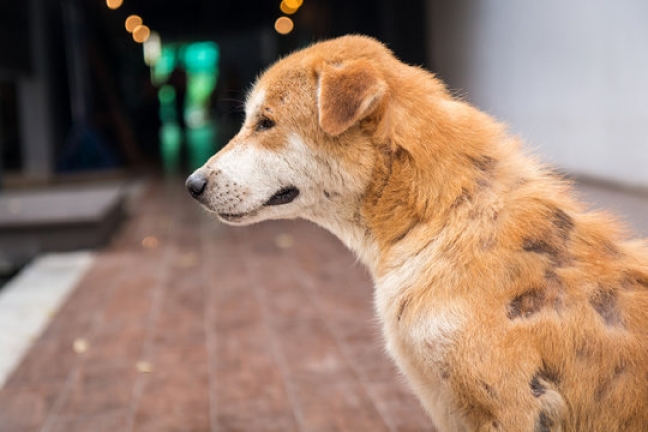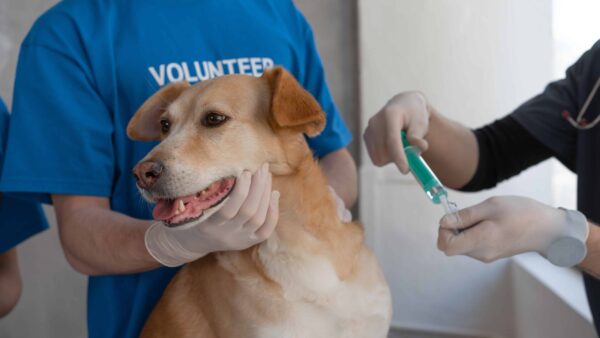Dogs are highly energetic; they are always ready to run around and engage in activities. Unfortunately, their active nature makes them prone to injuries and skin issues, which can lead to the formation of scabs.
Scabs can be unsightly and uncomfortable for our furry companions; it usually inhibits hair growth, and your dog may experience temporary baldness in the spot of the scab.
However, you should know that scab is among the part and parcel of the healing process in dogs.
As a concerned pet parent, you may find yourself wondering, ‘How long does it take for a dog’s hair to grow back after a scab?’ The answer to this question is not straightforward, as it depends on the type and severity of the injury your dog has experienced.
In some cases, if the injury has severely affected the dog’s hair follicles, the baldness at the site of the scab may become permanent.
There is a lot to learn about scabs and dogs and in this article, we have revealed the healing process of scabs on dogs and also ways to promote healthy hair regrowth.
So, without further ado, let’s jump right in!
What Are Scabs
Scabs are protective crusts or dry, rough patches that form on the skin’s surface as part of the healing process.
They are made of fibrin (a protein that helps in blood clotting). When the skin is injured or irritated, scabs serve as a natural barrier to prevent further damage and allow the underlying tissues to repair themselves.
Scabs can vary in appearance, ranging from reddish-brown or yellowish crusts to raised or rough patches on the skin.
While scabs can be a normal part of the healing process, they can also indicate an underlying skin condition or injury that requires attention and care.
What Are the Causes of Scabs in Dogs
There are varieties of situations that can lead to the formation of scabs in dogs. Some of the common causes are:
- Allergies
- Fungi or Bacterial Infection
- Injury
- Skin Irritants such as flea or tick bite
- Underlying health conditions such as mange or skin cancer
Understanding Dog Hair Growth Cycle

Similar to humans, dogs have a hair growth cycle consisting of three phases: anagen, catagen, and telogen.
Understanding these phases and what influences them will make you gain more insight into the reasons behind differences in the time it takes for hair to regrow after a wound in different dogs.
The anagen phase is the active growth phase, during which the hair follicles produce new hair.
The catagen phase is a transitional phase, and the telogen phase is the resting phase before shedding.
This cycle varies in duration as several factors such as genetics, overall health, diet, hormonal imbalances, and environmental factors can influence a dog’s hair growth rate.
How Long for Dogs Hair to Grow Back After Scab
The timeframe for hair regrowth after a scab largely depends on the severity of the injury or underlying condition.
In minor cases, where the scab is caused by a small or superficial injury, the hair may start growing back within 1 -2 weeks.
For scabs caused by deep cuts or lacerations, the hair may start growing back between 4 – 5 weeks.
However, more significant injuries or chronic conditions may require several weeks or even months also additional medication for complete hair regrowth.
If the thing that leads to the formation of scabs has damaged the hair follicle of the dog, there will be permanent baldness on this spot.
How To Hasten Hair Growth in Dogs After Scabs or Injury
As a responsible pet owner, there are several ways you can promote healthy hair regrowth in your dog.
A good diet can play an active role in regrowing your dog’s hair. Ensure your dog receives a balanced diet rich in essential nutrients, including protein, vitamins, and minerals.
Regular grooming, such as brushing the affected area with a soft or bristle brush can stimulate blood circulation and remove dead hair cells, allowing new hair to grow.
You may also give your dog omega-3 fatty acids as a supplement. This oil helps your dog to maintain healthy skin and lustrous fur.
You may also consult with your veterinarian to ask for topical ointments or treatments made solely for hair regrowth. These ointments usually contain high levels of Vitamin A and E, biotin, and even caffeine. Yeah, Caffeine! It can help nourish hair follicles and stimulate hair regrowth.
By doing all these, your dog’s hair should start regrowing after a few weeks. If the dog’s fur remains defiantly absent, you should consult with your veterinarian.
How To Prevent Scabs in Dogs
1. Regular Grooming

Regular grooming plays a vital role in preventing skin issues that can lead to scabs.
Brushing your dog’s coat does not only removes loose hair but also helps distribute natural oils that keep the skin moisturized and healthy. It also allows you to detect any abnormalities on the skin’s surface, enabling early intervention if necessary.
2. Proper Nutrition
A nutritious diet is essential for maintaining a dog’s overall health, including its skin and coat.
Ensure your dog’s diet is balanced and provides the necessary nutrients for healthy hair growth. Consult with your veterinarian to determine the best diet for your dog’s specific needs.
3. Environmental Factors
Environmental factors, such as exposure to harsh chemicals, extreme temperatures, or parasites, can contribute to skin irritations and scabs.
Create a safe and clean environment for your dog, free from potential irritants or allergens.
Regularly inspect your dog’s living area and remove any potential hazards.
Conclusion
There is no stipulated time for a dog’s hair to grow back after a scab. It all depends on various factors such as dog breed, the severity of the injury, or the underlying condition.
While minor scabs may heal within a few weeks, more significant injuries or chronic conditions can require a longer recovery period.
However, you can help hasten the regrowth of hair after a scab by providing proper care, nutrition, and a stress-free environment for your dog.
You may also give your dog supplements such as Omega-3 fatty acid and also topical ointments made solely for dog hair regrowth.
If you notice that your dog’s hair is taking longer than expected to grow or your dog is experiencing symptoms such as foul odor from the injury spot, lethargy, continuous loss of coat, loss of appetite and weight, consult with your vet immediately and get your furry friend healthy and happy again!
Frequently Asked Questions
Can I Use Any Hair Growth Products to Speed Up the Process?
Yes, there are some ointments made solely for hair regrowth. However, it is always best to consult with your veterinarian before using any hair growth products on your dog. They can assess your dog’s specific condition and recommend suitable treatments, if necessary.
How Can I Prevent My Dog from Scratching or Licking the Scab?
Dogs are fond of licking and interfering with their injuries and this act deter the injury from healing.
To prevent your dog from scratching or licking the scab, you can use an Elizabethan cone collar or consider using pet-safe bitter sprays to deter them from licking the affected area.
Are Certain Dog Breeds More Prone to Scabs and Hair Loss?
Yes, some dog breeds are more prone to certain skin conditions or allergies that can lead to scabs and hair loss.
The breed also influences the rate at which hair regrows on a scab. For dogs with thinner hair density such as whippets or greyhounds, the hair regrowth may take longer time compared to dogs with plenty, of thick and double-coated fur.
Should I Be Concerned If My Dog’s Hair Is Taking Longer to Grow Back Than Expected?
If your dog’s hair is taking longer to grow back than expected or if you notice any concerning symptoms, it is advisable to consult with a veterinarian.
They can assess your dog’s condition and determine if any further intervention or treatment is required.
Should I Peel or Pick on My Dog’s Scab
No, picking or peeling your dog’s scab will disrupt the healing process and it will also expose the injury to infections and potential risks.
Scab is part and parcel of the healing process of an injury, it usually falls off by itself once the injury heals completely.
Peeling your dog’s scab will also cause potential scarring and increased pain. Instead of doing that, ensure the scab and its surrounding is always cleansed with a mild, pet-safe cleanser and water.







Leave a comment